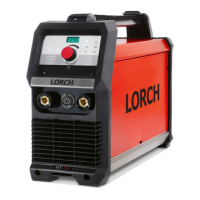Fundamentals
of
the MIG/MAG welding
proce
ss
LORCH
W
ire
el
ec
-
L
ong
ar
c/
Tr
ans
i
tio
n
tr
ode
di
-
S
hort
arc
a
meter
spray
arc
arc
mm
A
v A
v A v
0.8 1
40
...
23
...
110
..
18
...
50
..
.
14
..
180
28 150
22
130 18
1
.0
180
..
.
24
.
..
130
..
.
18
..
. 70 ... 16 ...
250
30
200
24
160 19
1.2
220
..
.
25
...
170
...
19
... 120
...
17 ...
320
32
250
26
200
20
1.6 260
..
. 26 ... 200
...
22
.
..
150 ...
18
...
320
34
300
28
200
21
Good
weld qualities are only achieved if the voltage and
cu
rrent are well balan
ced
.
VVhen
using
C02
an arc voltage whi
ch
is a
rou
nd
3 V larger
than required when u
sing
argon-
rich
gas mixtures.
Tab
. 8: Working ranges for MAG welding
Hol
ding
and
guid
ing the
to
rch
CD
With metal shielding gas welding, you can
n
o work in all posi
ti
ons: level, horizontally,
vertically
from top to bottom, vertically from
bottom to to
p,
overhead and in lateral posi-
tion.
For
level and horizontal and level welds, hold the torch
vertically (neutral torch position)
or
pushing
at
up to
30
°.
On
thicker layers you can also drag the torch slightly.
The neut
ra
l torch position produces the best penetration
depth and inert gas coverage. Take care not to
tilt t
he
torch too much, otherwise air could
be
d
ra
wn in
to
the
inert
gas
shie
ld
by
th
e injection effect.
If you are welding vertically and overhead then you
should push the torch slightly. Down welds are used
mainly for welding thin plates. In this case, hold the torch
in as
neutral or slightly dragging p
os
ition. This technique
requires specially trained and experienced
welders,
since there are dangers from incomplete fusion due to
the forward melt
pool. This danger increases wi
th
thicker
materials, or
if
the melt pool is very thin because the volt-
age is too high.
We
ld
di
rection pushing
We
ld directi
on
d
ra
ggi
ng
Fig. 13:
Torch
position
Avoid
la
rger oscillating movements in order
to
prevent
the melt pool from buildi
ng
up
in
front of the a
rc
. This can
lead to incomplete fusion due to the forward melt pool.
Exc
ept
in the vertical up position. you should oscillate
laterally only
as
far necessary to cover both edges
of
the
10.13
seam.
If
the seam is sufficiently wide, weld two beads
alongside each other.
If you are welding in the vertical up position, your oscilla-
tions should be in
the
shape of an open triangl
e.
Arc length
The longer the arc. the shallower is the penetration
depth, the wid
er
and flatter the weld bead and the great-
er
the tendency to spatter. The weld metal
is
transferred
in
slightly larger drops compared with a sho
rt
er arc. Use
a longer
arc
when fillet welding, in order to produce a flat
or concave
weld bead.
A shorter arc increases the penetration depth (at t
he
same current intensit
y)
, the weld bead is narrower and
the tendency to spatter is reduced. The weld metal is
tra
nsf
erred in finer drops until the short a
rc
is
reached.
Lo
ng
arc
Short arc
Fig. 14: Arc length
Electrode
wire
length
In general, the distance between
the
torch
and
the work-
piece is 10-12 times the wire diamete
r.
You can also
change the torch distance to affect the length of
the
free
end of
th
e electrod
e.
A longer free end
of
t
he
electrode reduces the current
intensity and the penetration dept
h.
A shorter free end of the electrode increases the current
intensity
while maintaining the same wire feed rate.
Lo
ng
electrode end Short electrode end
Fig.
15: Electrode wire length
-
21
-

